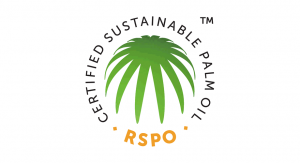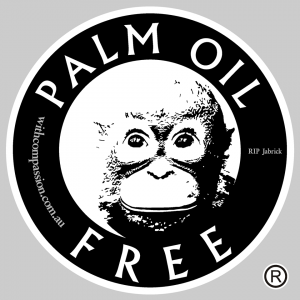
Global production of palm oil has undergone a phenomenal growth in recent years.
Demand is increasing rapidly and, unless checked, is expected to more than double by 2030 and triple by 2050!
The environmental impact of this projected increase would be catastrophic.
Palm oil trees grow best on land that has not been previously used for agriculture, which means primary rainforests are cleared to make room for expanding palm plantations. Its production destroys rainforest habitats and makes a significant contribution to the spiralling decline of the planet’s biodiversity.
Deforestation also has a real impact on global warming, as the forests play a crucial role in reducing greenhouse gasses by absorbing carbon from the atmosphere.
Currently we cut down over 15 billion trees each year, many from the world’s rainforests. Far and away the top driver of this deforestation is beef and soy production, but palm oil production is not far behind. It accounts for the loss of 21 million hectares of rainforest, mainly in Southeast Asia.

This increasingly controversial ingredient is almost certainly present in some form in nearly every room of your house.
It can be quite hard to avoid; it is estimated that it is found in about 50% of supermarket products, from food to household cleaning products, cosmetics, soaps and shampoos.
In this article we look at why palm oil is used so widely in products and suggest practical steps you can take to reduce your use and help protect the planet’s biodiversity.

What Is Palm Oil?
Palm oil is a type of vegetable oil which comes from the fleshy fruit of the oil palm Elaeis guineensis. You will often see it described as this species oil and not palm oil which disguises the ingredient name.
The palm is native to West Africa, but it grows successfully in any humid tropical climate and today is grown throughout the world.
It is a very high yielding crop which takes between 3-4 years to mature and produce fruit. This makes it cheap to produce. The palm fruit itself develops in bunches which contain hundreds of individual fruits about the size of a small plum.
The tree produces two types of oil. Palm oil which is obtained from the flesh of the fruit, and palm kernel oil, produced by extracting the oil from the seed of the fruit.
Unlike many vegetable oils, it has a particularly high concentration of saturated fat which makes it semi-solid at room temperature. This property makes it a particularly useful ingredient.
Unrefined palm oil, called red palm oil has a reddish-orange colour. This colour stems from antioxidants known as carotenoids which your body can convert into vitamin A. It is also a significant source of vitamin E.
 Can Palm Oil Be Produced Sustainably?
Can Palm Oil Be Produced Sustainably?
To produce Certified Sustainable Palm Oil (CSPO), companies must comply with a set of environmental and social criteria set by the Roundtable on Sustainable Palm Oil (RSPO)
These aim to help to minimise the negative impacts of palm oil cultivation by providing stronger protection for forests and the communities that live in them.
This is encouraging, and some companies now only use palm oil produced in this way. However RSPO-certified growers only account for 19% of global palm oil production, which means over 80% of palm oil is considered unsustainable.
Why Is It Used So Widely In Food?
The food industry is responsible for 72% of palm oil use world wide.
Biscuits and margarine – It is semi solid at room temperature and so is considered healthier fat ingredient than other vegetable oils because it doesn’t contain trans fats. Other vegetable oils have to be partially hydrogenated to make them more solid which creates trans fats.
Cakes and Bread – It is also resistant to oxidation which means that when added to bakery products it gives them a longer shelf life .
Crispy snacks and cereals – stable at high temperatures, it helps to give fried and baked products a crispy and crunchy texture.
Nut butters – added to nut butters as a stabilizer. It prevents the oil from separating and settling at the top of the jar.
Pet food – used as a filler. It is edible, heat resistant and contains natural preservatives, giving pet food a longer shelf life.
Fast food and Frozen ready meals – Palm oil enhances the taste of processed food. It is added to frozen meals to prevent them from sticking and it functions as a natural preservative in processed meals.
Chocolate – The oil gives a smooth and shiny appearance to chocolate and chocolate spread. Also, it helps to stop it melting as easily in warmer temperatures.
Infant formula milk – Palm oil is used in infant formula to replicate a fatty acid that is present in human breast milk. It is the primary fat present in instant formula. It is also used to make it creamy in texture.
Why Are Palm Oils Used In Cosmetics and Cleaning Products?
Cosmetics and cleaning products are responsible for 18% of palm oil use world wide.
Soaps, Shampoos and Detergents – It provides the foaming agent for detergents.
Lipsticks – It is odourless and colourless and makes the application smoother. It does not melt at high temperatures and holds colour well.
Skin creams – its nutrient-dense profile make it beneficial for skin health. It gives the moisturiser anti-aging properties as well as moisture for softer, more supple skin.
Shaving creams – It helps to create a thick, stable lather that enfolds follicles and holds them upright.
 How to Spot if Palm Oil is in a Product
How to Spot if Palm Oil is in a Product
Since 2014 the EU law on food information to consumers has ensured that any food items containing palm oil must be labelled as such.
However this law only applies to food items and doesn’t cover palm oil derivatives either in food and non-food items.
About 60% of the palm oil we consume appears in these processed forms (derivatives) of the oil.
Derivatives to look out for on labels are:
Palmate, Palmitate, Palmolein, Glyceryl, Stearate, Stearic Acid, Elaeis Guineensis, Palmitic Acid, Palm Stearine, Palmitoyl Oxostearamide, Palmitoyl Tetrapeptide-3, Sodium Laureth Sulphate, Sodium Lauryl Sulphate, Sodium Kernelate, Sodium Palm Kernelate, Sodium Lauryl Lactylate/Sulphate, Hydrated Palm Glycerides, Ethyl Palmitate, Octyl Palmitate, Palmityl Alcohol
Look out for the Palm Oil Free logo or the RSPO logo on products.
The oil has insinuated itself into every corner of our lives. It is a perfect, cheap commodity for industry after industry, each of which has adopted it and never turned back. The negative environmental impact of this ingredients success is enormous, but we can all play our part in reversing this trend.
Determining which products contain palm oil, and how sustainably it has been sourced, requires an almost supernatural level of consumer focus.
 Can Palm Oil Be Produced Sustainably?
Can Palm Oil Be Produced Sustainably?
Leave a Reply